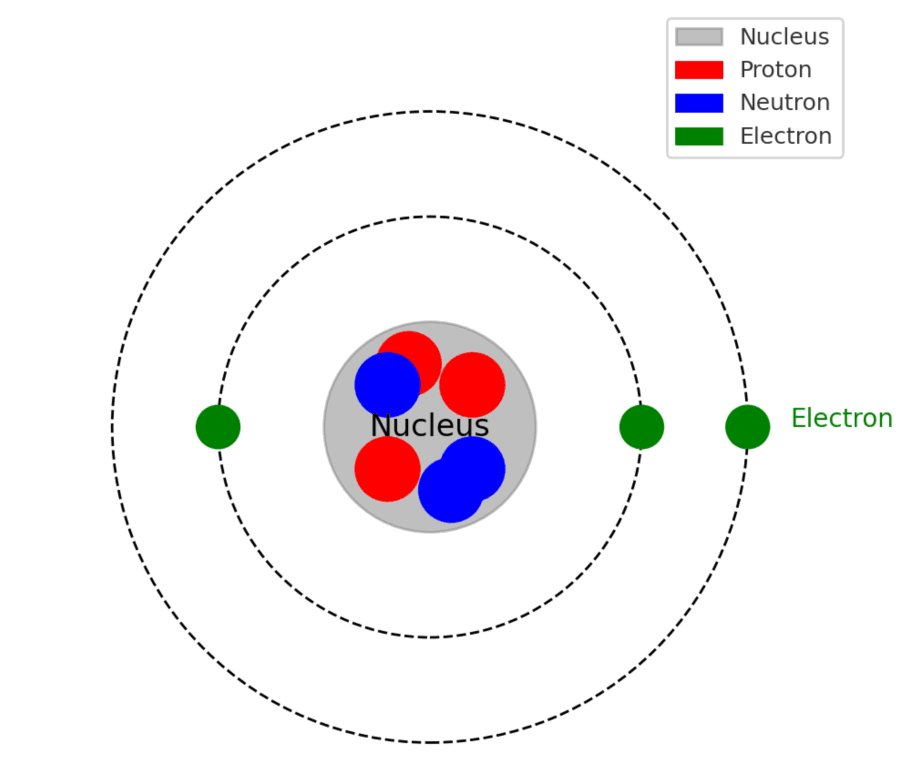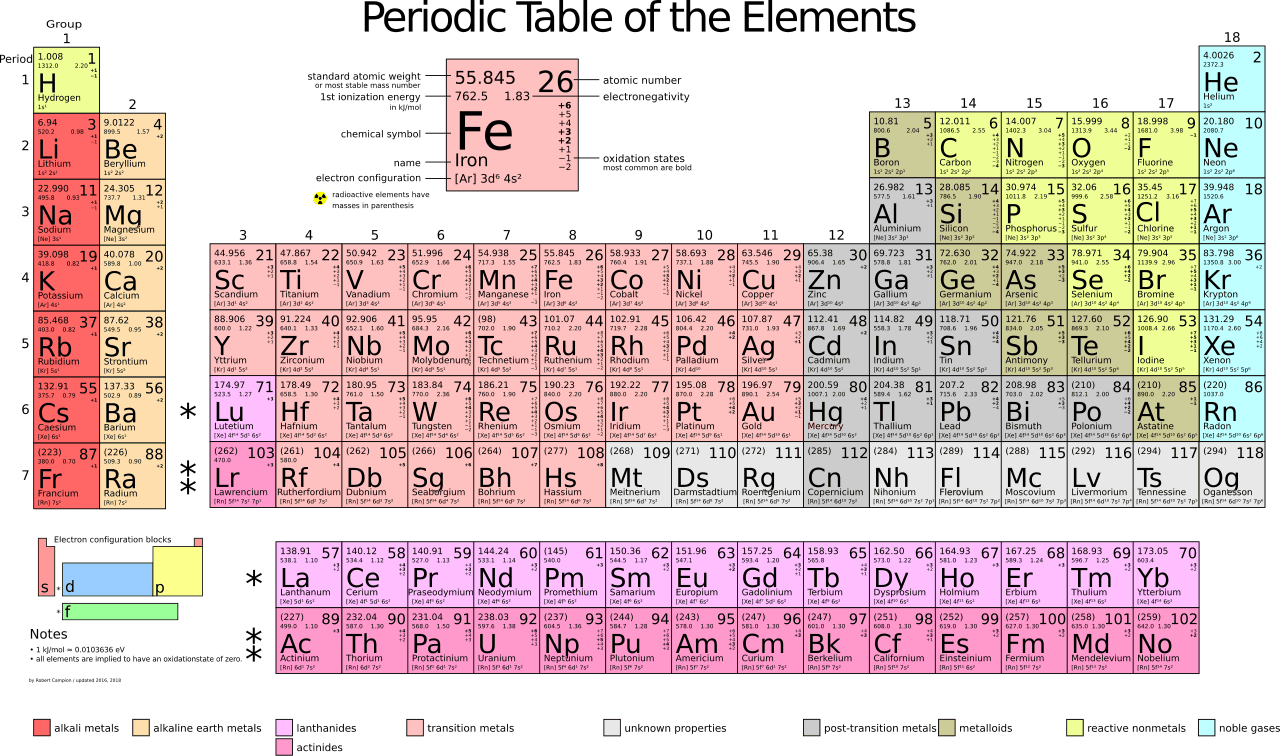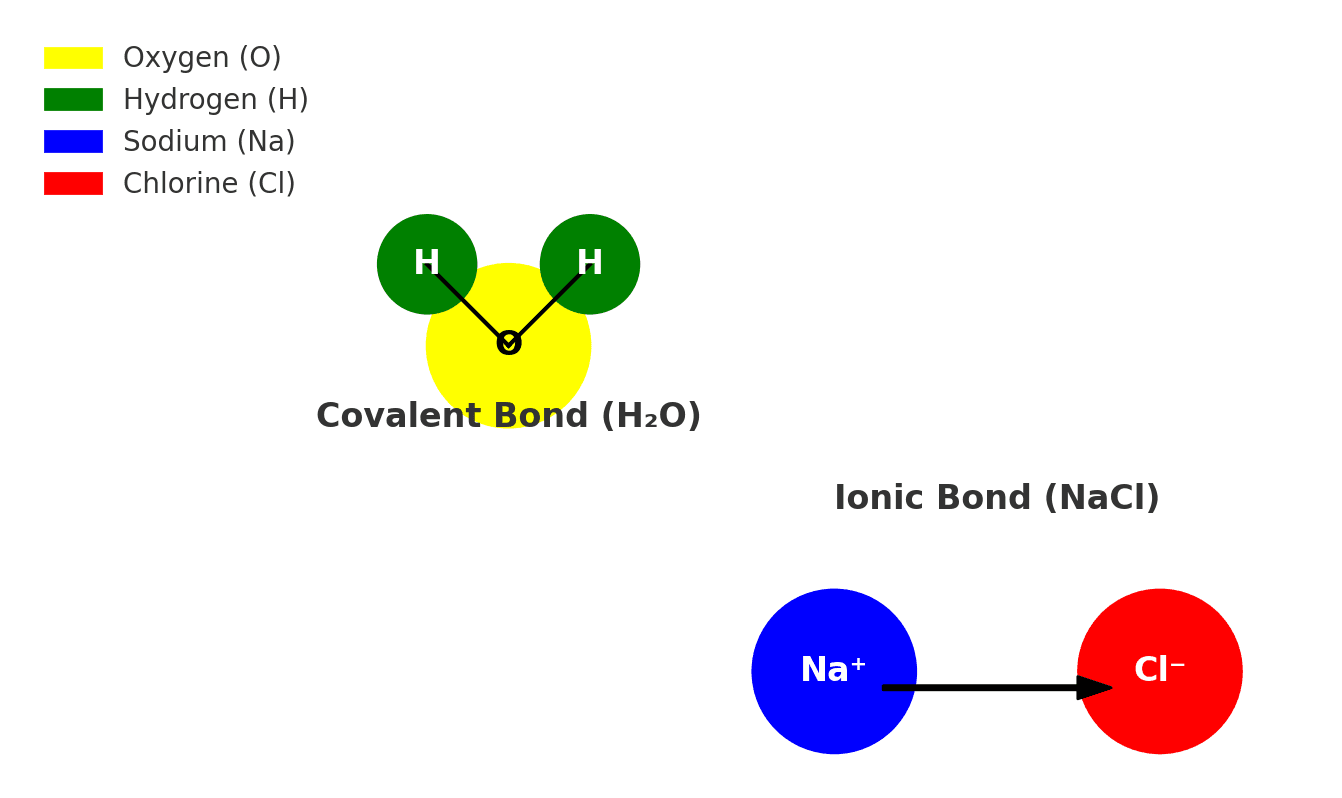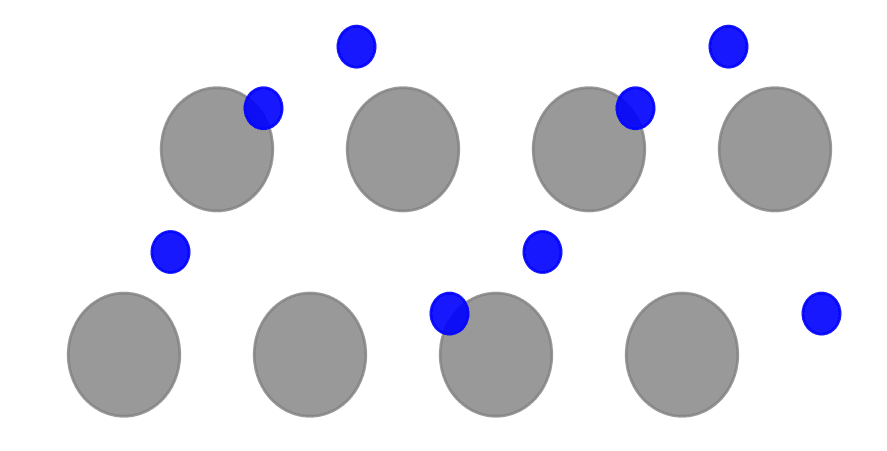Chemistry is the branch of science that studies matter and its interactions. It explains everything from the composition of atoms to the formation of complex molecules. In this article, we’ll break down the core concepts of chemistry in a simple and easy-to-understand way.
Understanding Atoms—The Building Blocks of Matter
Atoms are the smallest units of matter that retain the properties of an element. They consist of three primary particles:
- Protons – Positively charged particles found in the nucleus.
- Neutrons – Neutral particles also found in the nucleus.
- Electrons – Negatively charged particles that orbit the nucleus in energy levels.
Atoms are incredibly small—millions can fit on the tip of a needle! Their unique properties depend on the number of protons contained in its nucleus, which defines the element.
Here is a basic diagram of a lithium atom. It shows:
- Nucleus (gray) containing:
- Protons (red)
- Neutrons (blue)
- Electrons (green) orbiting in two energy levels:
- Two electrons in the first shell
- One electron in the second shell
Dashed lines represent the electron orbits (orbitals), highlighting the structure of a lithium atom.

Elements and the Periodic Table
Elements are pure substances made up of only one type of atom. Each element is identified by the number of protons in its nucleus, also known as the atomic number. For example:
- Hydrogen (H) → 1 proton
- Oxygen (O) → 8 protons
- Carbon (C) → 6 protons
The Periodic Table arranges elements based on their properties, atomic number, and electron configurations. It categorizes elements into metals, non-metals, and metalloids, each with unique chemical behaviors.
- Metals: These elements are typically shiny, good conductors of heat and electricity, and malleable. Examples include iron (Fe), copper (Cu), and gold (Au).
- Non-metals: These elements are usually not shiny, are poor conductors of heat and electricity, and are brittle when solid. Examples include oxygen (O), nitrogen (N), and sulfur (S).
- Metalloids: These elements have properties that are intermediate between metals and non-metals. They can exhibit characteristics of both categories under different conditions. Examples include silicon (Si) and boron (B).
The periodic table’s organization helps in understanding the properties and relationships of different elements.

Molecules and Compounds: How Atoms Combine
Atoms can join together to form molecules and compounds:
- Molecules: Two or more atoms bonded together (e.g., O₂ – oxygen molecule).
- Compounds: Molecules composed of different elements in fixed ratios (e.g., H₂O – water).
The difference? Elements contain only one type of atom, while compounds contain multiple different atoms chemically bonded together.
Chemical Bonding—The Forces That Hold Atoms Together
Atoms combine to form molecules and compounds through chemical bonds. There are three main types:
- Covalent Bonds – Formed when atoms share electrons to achieve stability (e.g., H₂O – water).
- Ionic Bonds – Formed when one atom transfers electrons to another. This creates ions (charged atoms), which attract each other (e.g., NaCl – table salt).
- Metallic Bonds – Found in metals, where electrons move freely, making metals good conductors of electricity.
Covalent and Ionic Bonds

Metallic Bond

Chemical Reactions: How Matter Transforms
A chemical reaction occurs when substances (reactants) interact to form new substances (products). Chemical reactions obey the law of conservation of mass, meaning no atoms are created or destroyed—just rearranged.
Common Types of Chemical Reactions
- Synthesis Reaction: Two or more substances combine (A + B → AB).
- Decomposition Reaction: A compound breaks down into simpler substances (AB → A + B).
- Single Replacement: One element replaces another in a compound (A + BC → AC + B).
- Double Replacement: Ions in two compounds swap places (AB + CD → AD + CB).
For example, the reaction where hydrogen (H₂) combines with oxygen (O₂) to form water (H₂O) is an example of a synthesis reaction. In this type of reaction, two or more substances combine to form a more complex compound(H₂O).
Acids, Bases, and the pH Scale
Acids and bases play an important role in chemistry. The pH scale (0-14) measures how acidic or basic a solution is:
- Acids (pH < 7) – Release hydrogen ions (H⁺) in water. Example: Lemon juice (pH 2).
- Neutral (pH = 7) – Water (H₂O).
- Bases (pH > 7) – Release hydroxide ions (OH⁻). Example: Baking soda (pH 9).
Acids and bases neutralize each other to form water and a salt.

Stoichiometry—Balancing Chemical Equations
Stoichiometry is the calculation of reactants and products in a chemical reaction. It is based on:
- Balanced Equations – The number of atoms on the reactant side must equal the number on the product side.
- Mole Ratios – Defined by the balanced equation to determine how much of a substance reacts or forms.
For example, in the combustion of methane:
CH4 + 2O2 → CO2 + 2H2O
One methane molecule reacts with two oxygen molecules to form carbon dioxide and water.
Solutions and Mixtures
Chemistry also deals with different forms of matter:
- Solutions – A homogeneous mixture where substances dissolve completely (e.g., saltwater).
- Mixtures – A physical blend of two or more substances, which can be:
- Homogeneous – Evenly mixed (e.g., air).
- Heterogeneous – Unevenly mixed (e.g., salad).
- Suspensions – A heterogeneous mixture where particles settle over time (e.g., muddy water).
Molar Mass
Molar mass is the weight of one mole of a substance, measured in grams per mole (g/mol). It helps determine the quantity of a substance needed for chemical reactions.
For example:
- The molar mass of H₂O (water) is: (2 × 1) + (1 × 16) = 18 g/mol.
By knowing molar mass, scientists can calculate how much of a substance is required in a reaction.
Key Concepts
Chemistry is essential for understanding the physical world. Here’s what we covered:
- Atoms, elements, and the periodic table help classify substances.
- Molecules and compounds are formed when atoms bond together.
- Chemical bonding (ionic, covalent, and metallic) determines how atoms connect.
- Chemical reactions involve breaking and forming new bonds.
- Acids, bases, and the pH scale explain how substances behave in solutions.
- Stoichiometry allows us to calculate reactants and products.
- Solutions and mixtures define different forms of matter.
- Molar mass helps in measuring chemical quantities accurately.
Understanding these basics will give you a solid foundation in basic chemistry!
What Do You Think?
Did this help simplify chemistry for you? If you found it useful, leave a comment below and share your thoughts! Chemistry is all around us—what topic would you like to learn about next? Let’s discuss!
